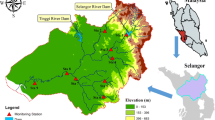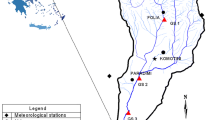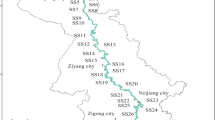Abstract
Local water quality indices (WQIs) are usually developed by modifying internationally recognized indices, which are considered reference index. In previous works on WQIs, the performance of local and reference indices has not been compared with each other. Therefore, the question crosses the mind whether using local or international indicators individually can show all qualitative aspects of a water resource. In this study, it was aimed to make this comparison between NSFWQIm (National Sanitation Foundation Water Quality Index) as the reference index and IRWQIsc (Iranian Water Quality Index for Surface Water Resource-Conventional Parameters) as the local one through a case study (Sefidroud River in northern Iran). Based on the results, the indices’ performance in representing the seasonal and spatial fluctuations of the river water quality was almost similar. However, the water quality scores obtained by the two indices were somewhat different. Based on NSFWQIm, the average water quality score of the river was about 49.0, by which the water was categorized in “bad” class, while IRWQIsc represented an average score of 56.1, which corresponds to “fairly good” class. Therefore, NSFWQIm identified the water quality with stricter criteria than IRWQIsc, regarding the public health. On the other hand, according to relative standard deviations (0.17 for NSFWQIm, 0.21 for IRWQIsc) of the obtained water qualities, IRWQIsc better distinguished between high and low water qualities of the river. Accordingly, in order to better interpret the quality conditions of surface water resources in Iran, it is necessary to use both indices since NSFWQIm (reference index) attracts attention to stricter international standards and requirements, while IRWQIsc (local index) causes more focus on seasons or locations with the worst water quality.





Similar content being viewed by others
References
Aazami, J., Esmaili-Sari, A., Abdoli, A., Sohrabi, H., & Van Den Brink, P. J. (2015). Monitoring and assessment of water health quality in the Tajan River, Iran using physicochemical, fish and macroinvertebrates indices. Journal of Environmental Health Science and Engineering, 13(1), 29.
Akkoyunlu, A., & Akiner, M. E. (2012). Pollution evaluation in streams using water quality indices: a case study from Turkey’s Sapanca Lake Basin. Ecological Indicators, 18, 501–511.
Alexakis, D. (2011). Assessment of water quality in the Messolonghi–Etoliko and Neochorio region (West Greece) using hydrochemical and statistical analysis methods. Environmental Monitoring and Assessment, 182, 397–413.
Alexakis, D., Gotsis, D., & Giakoumakis, S. (2012). Assessment of drainage water quality in preand post-irrigation seasons for supplemental irrigation use. Environmental Monitoring and Assessment, 184, 5051–5063.
Alexakis, D., Tsihrintzis, V. A., Tsakiris, G., & Gikas, G. D. (2016). Suitability of water quality indices for application in lakes in the Mediterranean. Water Resources Management, 30(5), 1621–1633.
Amiri, V., Rezaei, M., & Sohrabi, N. (2014). Groundwater quality assessment using entropy weighted water quality index (EWQI) in Lenjanat, Iran. Environmental Earth Sciences, 72(9), 3479–3490.
Baghapour, M. A., & Shooshtarian, M. R. (2017). Assessment of groundwater quality for drinking purposes using water quality index (WQI) in Shiraz, Iran (2011 to 2015). Iranian Journal of Health, Safety & Environment, 5(1), 888–893.
Brown, R. M., McClelland, N. I., Deininger, R. A., & Tozer, R. G. (1970). A water quality index-do we dare? Water & Sewage Works, 117(10), 339–343.
CCME. (2001). Canadian water quality guidelines for the protection of aquatic life: CCME water quality index 1.0, user’s manual. Winnipeg: Canadian Council of Ministers of the Environment.
Cerqueira, T. C., Mendonça, R. L., Gomes, R. L., de Jesus, R. M., & da Silva, D. M. L. (2020). Effects of urbanization on water quality in a watershed in northeastern Brazil. Environmental Monitoring and Assessment, 192, 65.
Ding, S., & Shi, Z. (2005). Studies on incidence pattern recognition based on information entropy. Journal of Information Science, 31(6), 497–502.
DOE (Department of Environment, Islamic Republic of Iran), Guideline for calculating water quality index in Iran. In Persian, https://www.doe.ir/portal/file/?958505/5-WriteBuffer.pdf
Dunnette, D. A. (1979). A geographically variable water quality index used in Oregon. Journal of the Water Pollution Control Federation, 51(1), 53–61.
Ewaid, S., Salwan, A. A., & Safaa, A. K. (2018). Predicting the Tigris River water quality within Baghdad, Iraq by using water quality index and regression analysis. Environmental Technology and Innovation, 11, 390–398.
Fagbote, E. O., Olanipekun, E. A., & Uyi, H. S. (2014). Water quality index of the ground water ofbitumen deposit impacted farm settlements using entropy weighted method. International journal of Environmental Science and Technology, 11(1), 127–138.
Gao, Q., Li, Y., Cheng, Q., Yu, M., Hu, B., Wang, Z., & Yu, Z. (2016). Analysis and assessment of the nutrients, biochemical indexes and heavy metals in the Three Gorges Reservoir, China, from 2008 to 2013. Water Research, 92, 262–274.
Gikas, G. D., Sylaios, G. K., Tsihrintzis, V. A., Konstantinou, I. K., Albanis, T., & Boskidis, I. (2020). Comparative evaluation of river chemical status based on WFD methodology and CCME water quality index. Science of the Total Environment, 745, 140849.
Hamedi, H., Mobarghai, N., Soufizadeh, S., & Rasouli, S. A. (2015). Survey of qualitative conditions and seasonal variation of the urban watercourses pollutants. Journal of Materials and Environmental Science, 6(2), 322–332.
Hoseinzadeh, E., Khorsandi, H., Wei, C., & Alipour, M. (2015). Evaluation of Aydughmush river water quality using the National Sanitation Foundation Water Quality Index (NSFWQI), River Pollution Index (RPI), and Forestry Water Quality Index (FWQI). Desalination and Water Treatment, 54(11), 2994–3002.
Jamshidi, S., Mahjoubi, E., & Ardestani, M. (2016). Feasibility of discharge permit market in rivers. Iranian Journal of Geology, 9(36), 56–67 In Persian.
Lumb, A., Sharma, T. C., Bibeault, J. F., & Klawunn, P. (2011). A comparative study of USA and Canadian water quality index models. Water Quality Exposure and Health, 3, 203–216.
Mahab Ghodss Consulting Engineering Company, (2010). Master plan of Gilan province water resources management. Environmental studies report, In Persian.
Makhlough, A., Nasrollahzade, H., Parafkande, F., Fazli, H., Mirzaie, R., Hosseinpoor, H., Keihansani, A. R., & Doostdar, M. (2017). Monitoring water quality and eutrophication phenomenon of Azad Dam using Iranian Water Quality Index and Carlson’s Trophic State Index. Iranian Scientific Fisheries Journal, 26(2), 69–78 In Persian.
Medeiros, A. C., Faial, K. R. F., do Carmo Freitas Faial, K., da Silva Lopes, I. D., de Oliveira Lima, M., Guimarães, R. M., & Mendonça, N. M. (2017). Quality index of the surface water of Amazonian rivers in industrial areas in Pará. Brazil. Marine Pollution Bulletin., 123, 156–164.
Mirmoshtaghi, S. M., Amirnezhad, R., & Khaledian, M. (2011). Sefidroud river water quality assessment and its mapping according to NSFWQI and OWQI water quality indicators. Journal of Wetland Ecobiology, 3(9), 23–34 In parsian.
Moravatdoust Anarkoli, M., Haeripour, S., & Amirnezhad, R. (2015). Study of Sefidroud river water quality in Roudbar. Journal of Wetland Ecobiology, 7(3), 33–43 In Persian.
MPCB. (2014). Compilation of water quality data recorded by MPCB 2011-12. India: Maharashtra Pollution Control Board.
Noori, R., Berndtsson, R., Hosseinzadeh, M., Adamowski, J. F., & Rabiee Abyaneh, M. (2019). A critical review on the application of the National Sanitation Foundation Water Quality Index. Environmental Pollution, 244, 575–587.
Saeedi, M., Abessi, O., Sharifi, F., & Meraji, H. (2010). Development of groundwater quality index. Environmental Monitoring and Assessment, 163, 327–335.
Said, A., Stevens, D. K., & Sehlke, G. (2004). An innovative index for evaluating water quality in streams. Environmental Management, 34(3), 406–414.
Samadi, J. (2016). Survey of spatial-temporal impact of quantitative and qualitative of land use wastewaters on Choghakhor wetland pollution using IRWQI index and statistical methods. Iran-Water Resources Research, 11(3), 159–171 In Persian.
Şener, Ş., Şener, E., & Davraz, A. (2017). Evaluation of water quality using water quality index (WQI) method and GIS in Aksu River (SW-Turkey). Science of the Total Environment, 584-585, 131–144.
Shannon, C. E. (1948). A mathematical theory of communication. Bell System Technical Journal, 27(379-423), 623–656.
Singh, K. R., Dutta, R., Kalamdhad, A. S., & Kumar, B. (2019). An investigation on water quality variability and identi fi cation of ideal monitoring locations by using entropy based disorder indices. Science of the Total Environment, 647, 1444–1455.
Singh, P. K., & Saxena, S. (2018). Towards developing a river health index. Ecological Indicators, 85, 999–1011.
Smith, D. G. (1990). A better water quality indexing system for rivers and streams. Water Research, 24(10), 1237–1244.
Sutadian, A. D., Muttil, N., Yilmaz, A. G., & Perera, B. J. C. (2016). Development of river water quality indices-a review. Environmental Monitoring and Assessment, 188(1), 58.
Terrado, M., Barceló, D., Tauler, R., Borrell, E., de Campos, S., & Barceló, D. (2010). Surface-water-quality indices for the analysis of data generated by automated sampling networks. TrAC Trends in Analytical Chemistry, 29(1), 40–52.
Tiri, A., & Boudoukha, A. (2010). Hydrochemical analysis and assessment of surface water quality in Koudiat Medouar reservoir, Algeria. European Journal of Scientific Research, 4(2), 273–285.
Wilcox, L. V. (1948). The quality of water for agricultural use. U.S Department of Agriculture. TEC Bulletin, 962, 1–40.
Funding
This paper is part of a master’s thesis that was conducted under the financial supports of the Iran University of Science and Technology (IUST).
Author information
Authors and Affiliations
Corresponding author
Additional information
Publisher’s note
Springer Nature remains neutral with regard to jurisdictional claims in published maps and institutional affiliations.
Rights and permissions
About this article
Cite this article
Ebraheim, G., Zonoozi, M.H. & Saeedi, M. A comparative study on the performance of NSFWQIm and IRWQIsc in water quality assessment of Sefidroud River in northern Iran. Environ Monit Assess 192, 677 (2020). https://doi.org/10.1007/s10661-020-08630-6
Received:
Accepted:
Published:
DOI: https://doi.org/10.1007/s10661-020-08630-6




